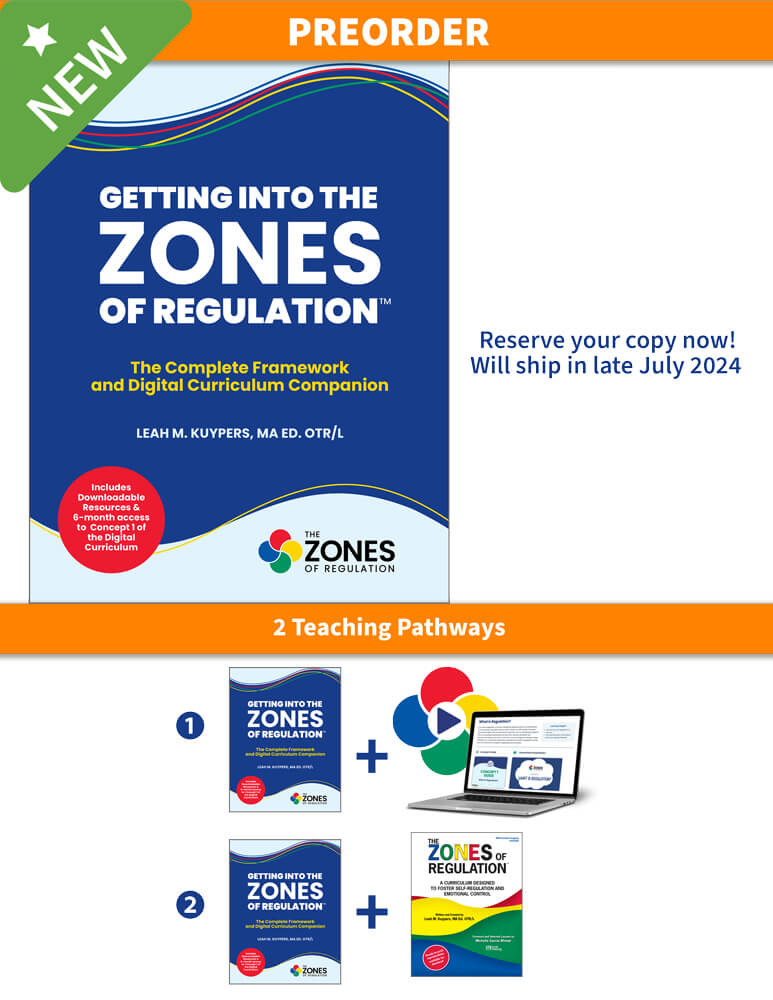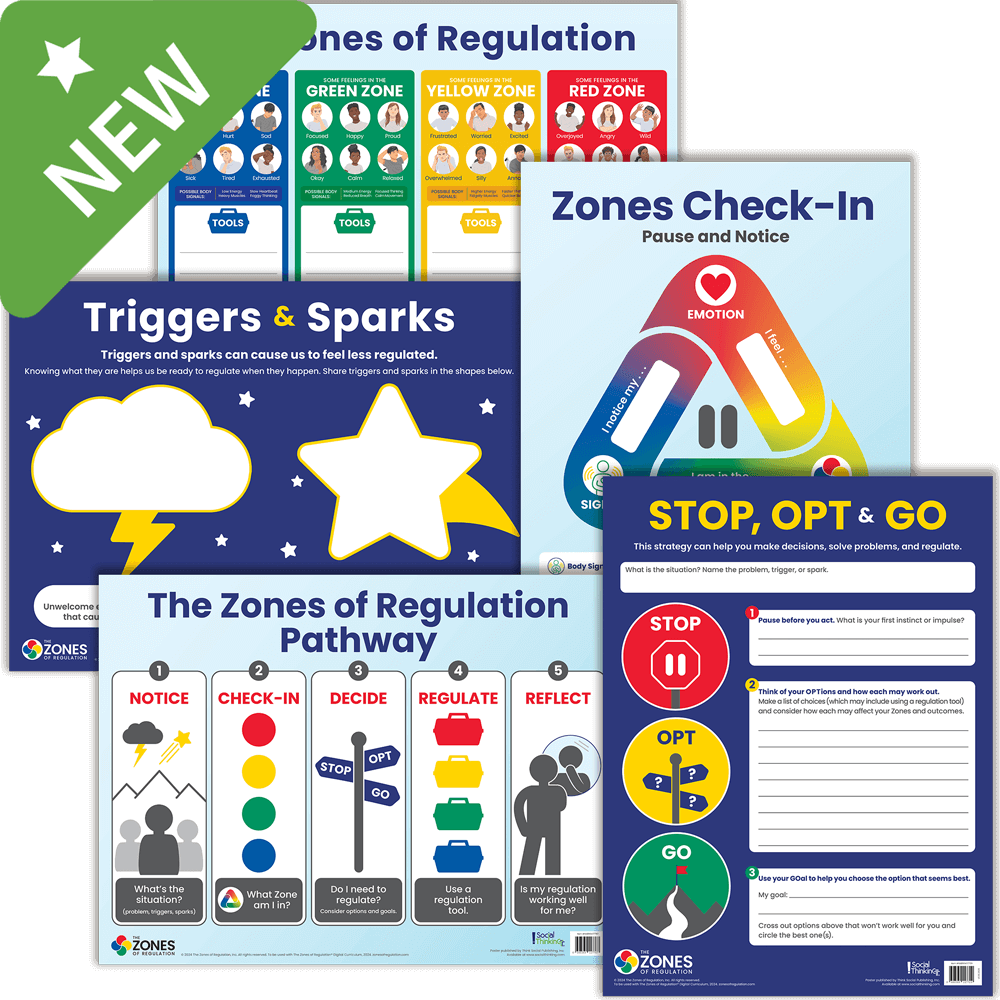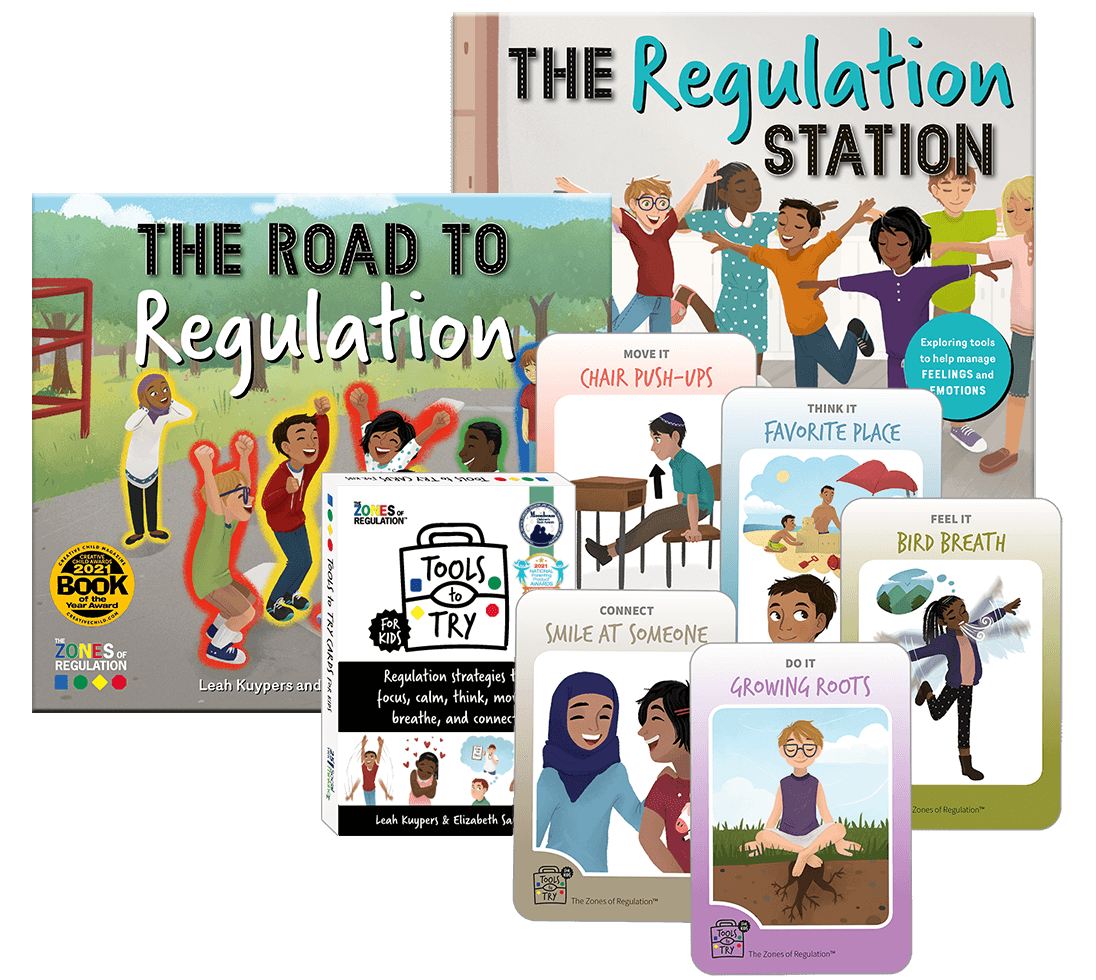
Click image to zoom.
Double click image to zoom.









- Ages: Adults
- Pages: 172
- Format: Paperback
- ISBN: 9781962301039
- Published: 2024
Description
Pre-order your copy of this new book now and receive a presale discount of 10% (use code LOVEJUNE10 valid through July 23rd).
As many of you have already heard, The Zones of Regulation Digital Curriculum will be launching in July of 2024 from the Zones website. This fully online platform is an interactive and accessible approach to help learners understand, communicate around, and care for their feelings. We know that some educators, therapists, and parents prefer having a book as well to supplement their teaching toolkit. That’s why we are publishing this companion print product: Getting Into The Zones of Regulation: The Complete Framework and Digital Curriculum Companion. Order now to receive a presale discount of 10% (use code LOVEJUNE10), with books shipping out at the same time as the digital platform launch.
Getting Into The Zones of Regulation is the must-have print companion to The Zones of Regulation Digital Curriculum, providing you with all the foundational knowledge and implementation guidance you need to teach the Zones with fidelity.
This guide orients you to the next evolution of The Zones of Regulation theory and methods and can be used in two ways: 1) to prepare you to teach the Digital Curriculum, or 2) to update your practices for those who already have the original Zones of Regulation Curriculum.
In addition, the book includes 6 months of FULL DIGITAL ACCESS to Concept 1 of the Digital Curriculum so readers can try out the many features including an Interactive Presentation and videos, visual supports, differentiated activities, and assessments.
Getting Into The Zones of Regulation includes the latest theory and teaching that reflects a decade of research and innovation, all in a well-designed, engaging, 160-page book, packed with brand-new visuals and the latest resources. The book includes:
- An in-depth exploration of regulation and underlying factors that impact its development, how social emotional learning (SEL) and regulation competencies correlate to overall positive outcomes for children, and how to understand the broad range of neurobiological, experiential, and cultural factors that impact regulation.
- A comprehensive and detailed explanation of The Zones of Regulation Framework and its Signature Practices.
- The essential elements needed to establish a Zones Climate within your setting.
- A chapter dedicated to explaining best practices for implementing The Zones of Regulation Digital Curriculum, along with assessments and tools for monitoring progress.
- A downloadable collection of resources that include adult-learning worksheets, student observation and data collection sheets, implementation planning tools, sample individualized regulation goals, and more.
With an easy-to-read fresh design and all new graphics and illustrations, Getting Into The Zones of Regulation explores many new facets of regulation to help better understand our learners and how best to support their growth and well-being.
The following all-new topics are included:
- Defining regulation and why it matters
- Regulation and social emotional learning (SEL)
- Development of regulation strategies
- Neurobiological considerations impacting regulation
- The impact of lived experiences on regulation
- ACEs/Trauma-informed care considerations
- Neurodiversity-affirming practices
- Culturally responsive teaching strategies
- Using a structured system for regulation
- Key tenets of The Zones of Regulation
- The Zones of Regulation Pathway
- How to create a Zones Climate
- Zones alignment to CASEL competencies
- Zones instructional models, scope, and sequence
- Adult social emotional learning (SEL) woven throughout
After reading this book, you will gain essential insights from author Leah Kuypers from decades of supporting regulation using The Zones of Regulation and the fundamentals you need to hit the ground running with The Zones of Regulation Digital Curriculum.
Preview 16 samples pages including the complete Table of Contents underneath the cover image at the top of the page!
Click here to order the NEW Zones of Regulation 5-Poster Set, a companion product to this book and the Digital Curriculum, with the latest content and fresh new designs.
Visit the Zones of Regulation website to learn more about the Digital Curriculum.
The original curriculum book, The Zones of Regulation™: A Curriculum Designed to Foster Self-Regulation and Emotion Control, will be available at a discount for a limited time. Contact Customer Service at for details.
Are you new to The Zones of Regulation?
The Zones of Regulation: A Curriculum Designed to Foster Self-Regulation and Emotional Control
This popular, easy-to-use regulation framework and award-winning curriculum builds safe, supportive environments that foster learning and well-being for all.
Learners benefit from:
- Increased self-awareness and social and emotional skills
- A common language for communication, problem solving, and emotional understanding
- More time spent on learning instead of on behavior management
- A healthier, more inclusive school climate
Regulation is something everyone continually works on whether we are aware of it or not. We all encounter trying circumstances that can test our limits. If we can recognize when we are becoming less regulated, we are able to do something about it to manage our feelings and get ourselves to a healthy place. This comes more naturally for some, but for others it is a skill that needs more attention and practice. This is the goal of The Zones of Regulation.
What are the Four Zones of Regulation?
Feelings come in different sizes, intensity, and levels of energy. To make this easy to talk and think about, we can categorize them into four simple, colored categories that we call Zones of Regulation.
The Blue Zone describes low levels of energy and down feelings, such as when we feel sad, tired, sick, or bored.
The Green Zone describes when we feel calm energy and in control. We might feel happy, focused, content, or proud in the Green Zone.
The Yellow Zone describes when our energy starts to get higher, and our feelings get a little bigger. We might be feeling worried, embarrassed, silly, excited, frustrated, or wiggly in the Yellow Zone.
The Red Zone describes when we have extremely high energy and big, intense feelings. We might feel really, really happy or elated, really angry or furious, panicked, devastated, terrified, or out of control in the Red Zone.
All of the Zones are experienced naturally, and the framework focuses on teaching individuals how to recognize and manage their Zones based on their goals and task demands. Learn more in the article, All the Zones Are OK! Tips for Managing the Zones You’re In.
The Zones of Regulation helps learners of all ages develop and refine their competency in regulation. In The Zones, we shift the lens from deficit-based thinking toward focusing on a strength-based, skill development mindset. In this way we honor each learner’s abilities, competencies, and strengths and focus on opportunities and possibilities for growth. The Zones of Regulation also helps solve the problem of behaviorally based interventions, which have been shown to be ineffective and even harmful. We’ve pioneered an alternative approach to practices that haven’t served learners or acknowledged their authentic experiences. The Zones of Regulation is a unique and systematic approach to help unpack some of the complexity of regulation and build the capacity to recognize when we’re in different physiological and emotional states, as well as pair tools that support regulation of that state. We call these states “The Zones,” with each of the zones represented by a distinct color. We categorize all the different ways we feel—including our feelings, energy levels, and states of alertness—into four colored zones. Using the four Zones, we can establish an easy language with visual supports and structure that not only help build competencies to self-regulate but also co-regulate with others.
The Zones of Regulation Curriculum incorporates principles of Cognitive and Dialectic Behavior Therapy (CBT/DBT)—common, metacognitively based, therapeutic methodologies to aid in emotional regulation. These approaches address increasing emotional and behavioral awareness, as well as monitoring, modifying, and evaluating one’s emotional response, including the timing, duration, and intensity of our feelings so we can do something difficult with more ease.
Who can teach The Zones of Regulation?
The Zones curriculum can be taught by anyone wanting to support individuals in fostering their regulation skills. This can include, but is not limited to, special and regular education teachers, occupational therapists, speech-language pathologists, psychologists, counselors, behaviorists, social workers, and caregivers.
Who can benefit from The Zones?
In short, almost everyone from four-year-olds to adults! Everyone struggles with regulation from time to time. Though The Zones of Regulation was initially developed for neurodivergent learners with identified regulation differences—including those with autism, ADHD, mental health challenges, and cognitive disabilities—it is now used with all types and ages of learners.
Using The Zones is contagious! It doesn’t just benefit the learner who is using the curriculum, it also spreads to impact and influence those who surround them—caregivers, specialist teachers, and other learners start talking about “being in the Blue Zone,” “needing to use a tool,” and “checking-in with my Zones.” Adults who teach The Zones often report deeper insight into their own states and feelings and become more aware of the tools they can use to regulate. Many general education teachers around the globe have adopted The Zones for use with their whole class, school, and even districtwide to address their learners’ social emotional learning—giving every child the chance to learn this vital life skill.
You may be interested in this published study of a public school district’s adoption of The Zones of Regulation curriculum as part of comprehensive mental health program in five schools to improve school safety.
Frequently Asked Questions
Do I need the new Getting Into The Zones of Regulation book if there’s a Digital Curriculum?
It’s personal preference. For Zones Leaders who like an organized, easy to access, comprehensive reference, Getting Into The Zones of Regulation™ is the all new, essential print companion to The Zones of Regulation™ Digital Curriculum, comprised of all the core information and handouts needed to teach the Zones with sensitivity and fidelity. (Included with this new print guide is 6-months of FULL DIGITAL ACCESS to Concept 1 of the Digital Curriculum.)
If I have the 2011 edition of the Zones of Regulation Curriculum, do I need the new Digital Curriculum?
The new Digital Curriculum is informed by the author’s work with learners, schools, families, practitioners, and community partners over the years. The lesson concepts found within include the best from the original curriculum, along with numerous enhancements to make implementation easier for you, as well as more engaging for your learners. These enhancements contained in each lesson concept include the following:
- Ready-to-use digital presentations with interactive activities and videos to engage learners.
- Integration of Universal Design for Learning (UDL) to minimize barriers for learners of different ages and abilities. This includes numerous extension activities geared for instruction at different ages and support levels.
- A Guide with detailed step-by-step teaching points and suggestions for differentiating and extending learning.
- Easy access to downloadable resources:
- Updated graphics, visual supports, and activity sheets
- Formative assessments
- School-to-home connection (The Bridge)
The Zones Digital Curriculum also includes the following new Zones of Regulation core content:
- What is Regulation?
- Intro to The Zones
- All The Zones are Okay
- My Signals, My Zones
- The Zones Check-In
- Situations that Trigger and Spark
- What Is a Regulation Tool
- Building a Zones Toolbox
- Deciding to Regulate
- The Zones Pathway
- Zones in Community
- Reflecting on Regulation
Can I still order The Zones of Regulation curriculum book (2011 edition)?
Yes, we will continue to sell the original curriculum by request through Social Thinking’s Customer Service department for a limited time.
Is The Zones of Regulation curriculum book (2011 edition) out of date?
Everything in the existing book is relevant and accurate. The Digital Curriculum will continue to expand on that core teaching.










PREORDER! Getting Into The Zones of Regulation: The Complete Framework and Digital Curriculum Companion (Print Edition)
Tell us something good!
There was a problem adding this comment. Plaease try later.
Please log in